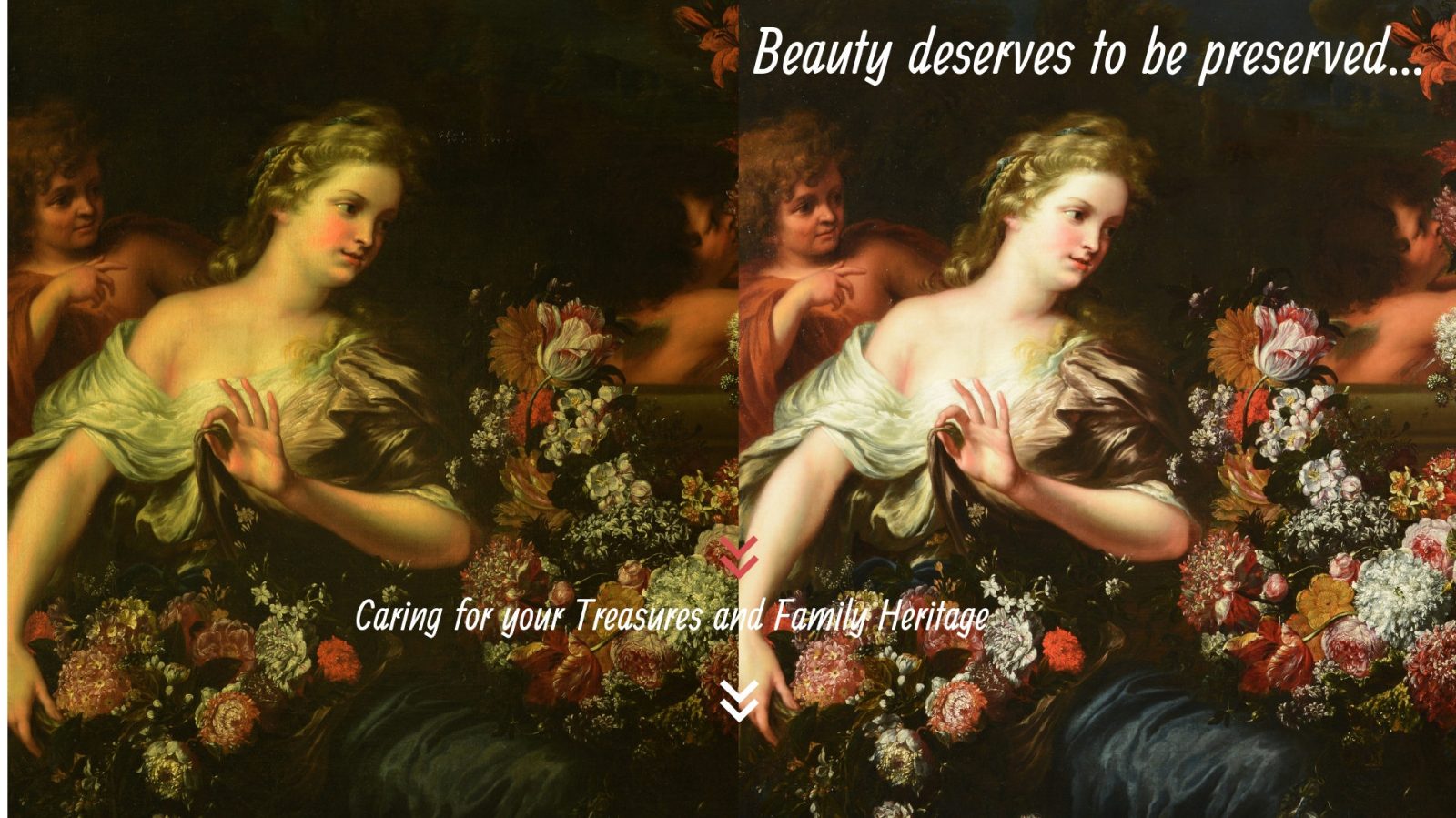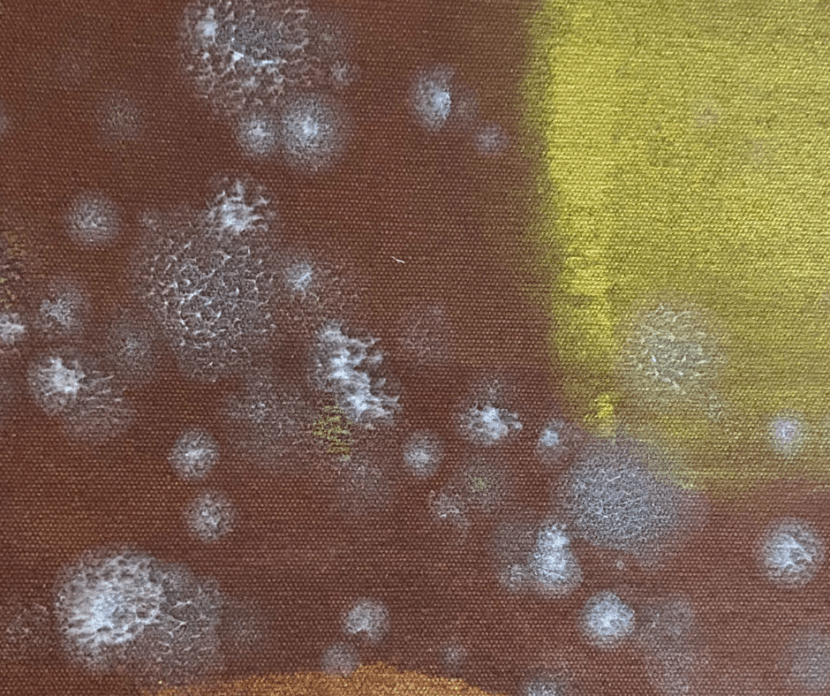Tips From Art Conservators About Preventing Mold Damage on Paintings
Being in the know can be crucial to prevent mold damage on paintings, especially in a humid environment such as South Florida. Whether you are an art lover, a seasoned investor, or a museum curator, knowing how mold grows is the first step toward saving your pieces from incurring serious damage. However, short of providing a rarefied environment, your works of art will be exposed to random mold spores and growth at some point.
Our goal is to provide art enthusiasts of all levels with the necessary information to detect and
remediate possible issues before their collections suffer irreversible damage.
The Importance of Protecting Your Art
Art is not just beautiful to look at, it is an investment and it should be protected.
Paintings are mainly created using cellulose-based materials, such as cotton, linen, paper, and wood. Proteinaceous materials such as leather, parchment, adhesives, and hair cloth are
particularly susceptible to direct attack by microorganisms.
Preventing mold damage on paintings, wooden frames, and other organic materials that are susceptible to mold growth is essential. Not only will mold and mildew destroy the artwork and its support infrastructure, but it will also weaken the substrate, leaving it vulnerable to further damage. This is because mold feeds on the enzymes contained in these materials, breaking them down and converting them to food.
This creates a vicious cycle as more materials are consumed and converted. Even after you
remove the mold, it could leave a stain on materials like wood, leather, and paper.
What Mold Needs to Grow
Mold spores are present in the air, on surfaces, and in cracks and cervices. Regardless of how careful you are in creating a safe environment, nothing is 100 percent fail-safe. However, you can make the environment less favorable by learning more about how mold spores attach to certain materials and the conditions needed for them to develop into fungus and
proliferate.
Although their viability decreases with age, dormant mold spores can remain on surfaces for years just waiting for the right conditions.
In order for mold to grow on artwork, you need:
* Nutrients: The materials that spores adhere to contain the very nutrients that mold needs to thrive. Fungus secretes enzymes that break these materials down and creates simple and complex carbohydrates, starches, and peptides, consuming the organic materials beneath the growth as it spreads.
* Moisture: Humidity and water vapor in the air become trapped in organic materials, providing enough moisture to swell mold spores and initiate germination.
* The right temperature: Although mold can survive for small periods of time in extremely low or high temperatures, all that is required for optimal growth is a temperature range of between 77°F and 86°F. Since most heritage collections are kept in rooms with an ambient temperature range of 59 – 77°F, you can see the need for climate-controlled rooms to house art.
* The proper pH: The acidity of the substrate will affect the germination, color, and growth of mold spores. Depending on the species of mold, the ideal pH for germination and growth is between 4pH and 7pH. However, mold can develop anywhere between 2pH and 9. Washing or deacidification will not hinder mold growth.
* Lack of air circulation: Creating a micro-climate that produces an even airflow and stable relative humidity (RH) may be the biggest determining factors in preventing mold growth.
* Lack of light: Like most fungi, mold prefers dark, moist conditions. Although more research is needed to determine that right amount of light, some studies have found that it can reduce the amount and direction of some species of mold growth.
Detecting the Presence of Mold
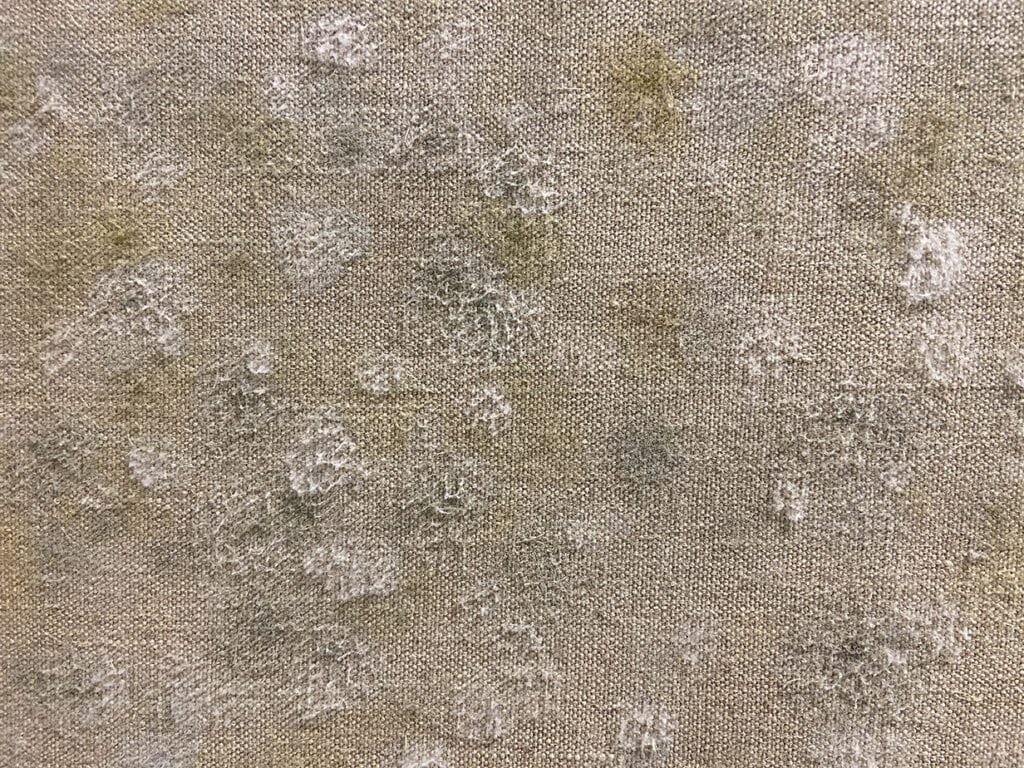
Normally, you can smell the presence of mold before you see it. There will be a musty odor in the air that’s characteristic of mold and mildew. Dormant spores don’t emit the characteristic smell, but new or light growth can be detected by using UV light, which causes the mold to appear luminescent.
Upon a careful visual examination, you’ll notice
slight stains that change the pigmentation on the surface materials. You may also detect a velvety or powdery deposit that can range from white or light, greenish gray to black. These may seem to be smudges of dirt or dust that smear and stick to the substrate when brushed.
Preventing Mold Growth
The best way to deal with mold is to prevent it in the first place by reducing or eliminating any environmental conditions that spur germination of mold spores. For example, the simple act of keeping the windows closed reduces outdoor mold spores by 2 percent. Using an electrostatic filtration system further reduces the presence of spores by 3 percent, and central air conditioning eliminates an additional 5 percent of outdoor spores.
In addition to keeping spores from invading your home or gallery, you can prevent spore germination by taking the following measures.
Controlling Relative Humidity
By controlling the level of moisture in the air, you can greatly improve your chances preventing mold growth. The amount of moisture absorbed into artworks depends, in part, upon the material of the substrate and the age of the art.
The relative humidity in museums and other exhibition areas should always be below 60 percent. You can control the RH in the room by:
* Placing dehumidifiers in rooms where art is stored or exhibited
* Monitoring RH. The best range is between 45 and 55 percent.
* Keeping the ambient temperature between 64°F and 68°F (18°C and 20°C)
* Only store art in closed cardboard boxes if it is for a short period of time.
Improving Air Circulation
Air circulation, moisture, and ambient temperature are best controlled by installing air
conditioners. Central air is best, but you can use small, portable air conditioners or fans if they
are adequate for the size of the room.
Controlling Ambient Temperature
When using large HVAC systems for heating and cooling, it’s important to maintain the proper levels of moisture in the air. This can be aided by keeping the temperature as low as possible when storing art work and using dehumidifiers in rooms that will be occupied by people.
Make sure that art is not stored or displayed against outside walls; a distance of 15 – 18 inches away is recommended. Prevent high moisture from leaks or outside air through proper ventilation, and repair any leaking pipes, downspouts, vents, or cracks in walls, flooring, ceilings, and windows or doors. Insulate pipes, ventilate attics or crawlspaces, and make sure to change air filters and service HVAC units regularly.
Starving the Mold
Like many works of art, books, clothes, furniture, and draperies are often made from organic materials that can be broken down into simple sugars, peptides, and amino acids. This is the food that mold loves and uses to thrive. Substrates and surfaces that are crafted from inorganic materials are also susceptible to mold infestations due to their age and surface build up due to dust, dirt, insect debris, and oils from handling. Mold spores also hide in dust.
You can prevent mold by depriving the spores of the nutrients they need. Stella Art Conservation offers a collection maintenance program that ensures preventative art conservation and prolonged enjoyment of your treasured pieces.
The Phases of Mold Remediation
Despite the best efforts, mold spores are inevitable. What you can do is prevent them from taking root and spreading. If you notice that a mold infestation is trying to take hold in your home, business, or museum, time is of the essence for remediation. The goal is to protect your art and your family or guests from the damage they can cause.
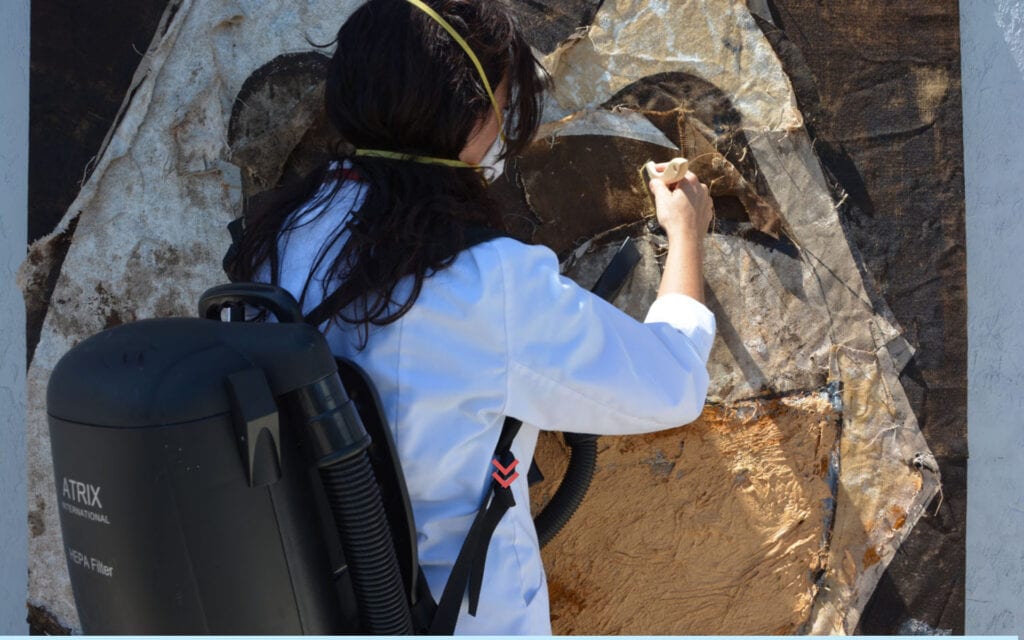
The first step is to isolate the affected piece or the entire collection, if more than one work is affected. This will contain the spread and prevent spores from infiltrating clean areas. Small works can be placed in a covered box until they can be decontaminated. Larger works can be covered with plastic sheeting temporarily. Close all windows and seal any vents with heavy plastic or polyethylene sheeting.
If any of the pieces are damp or exposed to water via rain, leak, or interior flooding, only wrap them until they can be dried out. This can be achieved by air drying in a closed, unventilated room or by using fans. Make sure to point fans away from the affected art to prevent blowing spores onto their surface.
In cases where air drying indoors isn’t possible due to the size or construction of the pieces, such as thicker works of art or pieces that are joined or layered, freezing is a good way to deactivate the spores and prevent the spread of mold. In the absence of a large, walk-in freezer at your location, you can rent a freezer truck for temporary storage and decontamination.
Keep in mind that freezing isn’t recommended for glass works and oil or acrylic paintings. Make sure to completely seal the works in plastic that is taped at the seams before freezing.
Now that you’ve isolated your individual pieces or collection, it’s time for some damage control and repair.
Step 1: Treat the Area
The first step of art conservation is to locate the source of contamination. Determine where the mold is coming from and correct the situation immediately. Go over our checklist of causes of mold and lower the level of humidity in the room, improve the air circulation, reduce the ambient temperature, and/or remove any standing water.
If necessary, contract a company that specializes in mold remediation or flood damage.
Step 2: Remove the Mold Without Causing Further Damage
Cleaning any artwork safely is no easy task, especially when it comes to removing mold. You
cannot spray it with household cleansers or put it in the washing machine. Artwork is delicate,
and one false move can cause irreparable damage. Ideally, ask your trusted Art Conservator to care for your art and perform mold remediation on your artworks. Do it as soon as possible, because time is essential in this kind of situation. At Stella Art Conservation we give maximum priority to mold remediation projects, we intervene as soon as we are contacted. It is very important to act promptly to prevent mold damage on paintings. Mold canseverely and permanently damage artworks, and so does a wrongfully executed mold remediation. Hence it highly recommended that you ask the help of a trusted professional.
Having said that, if you do not have an Art Conservator near you, before you begin any damage control and repair, you should do the research and opt for the least intrusive method or mold removal. If not performed well, you could damage your artworks.
Always make sure that you do the work in a well-ventilated area and wear a mask to protect yourself. Mold can be inhaled into the lungs and wreak havoc with your respiratory system.
Whenever possible, do the cleaning outside.
It is also important to clean according to the type of art you are dealing with. If you are an artist, cleaning your own art is easier because you know what materials and substrate was used.
Purchased art could be created with a variety of paints and substrates, each of which will react differently to attempts at mold removal and conservation.
For example, oils are some of the most durable paints, but they react badly to chemicals. Acrylic paints, on the other hand, can be damaged by exposure to water, they may also have a protective varnish over them. Watercolor paintings are almost exclusively done on paper and are among the most delicate types of painted artwork.
Step 3: Remove and Clean any Non-Art Surfaces
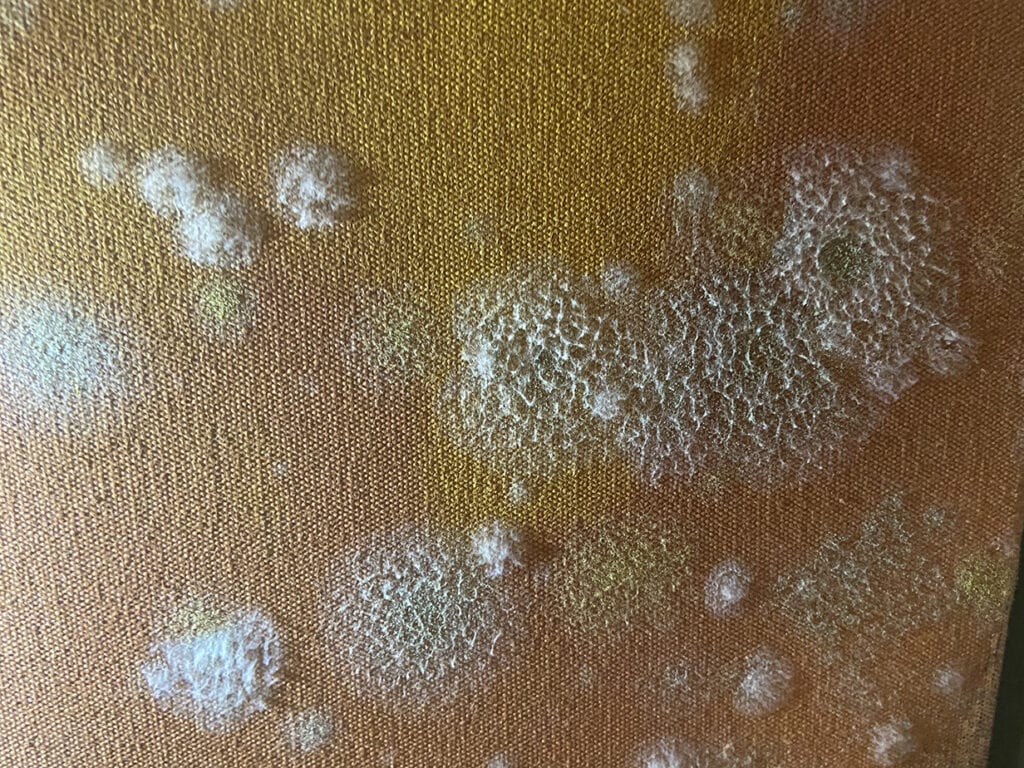
When paintings were covered for storage or displayed in frames, remove them from right away. The problem may have originated in an improperly climate controlled room or the frame may have attracted mold spores.
Keeping the collection in a moist room or damp, contaminated frame will promote mold growth.
If your paintings were wrapped in plastic for storage, remove the covering carefully and throw it away. Framed paintings that are covered in glass should be removed and the frame disassembled. To clean the glass take it to another room and clean it thoroughly with a solution of 10 percent bleach and distilled water. That is about one cup of bleach per gallon of water. Test any cleaning solutions on a small patch before committing to cleaning the entire glass. Do not perform any cleaning on gilded frames.
For art objects other than paintings, MOMA recommends that you brush away dry mold with a
soft bristled brush and the use of a HEPA filtered vacuum to remove any mold dust. You do not want the spores to fly in the environment. Consequently, you can treat the objects with a mixture of 70% commercial rubbing alcohol and distilled water. Either spray this mixture or you can use a cotton swab lightly dampened in the solution.
In case of paintings, the risk of using alcohol is too great and although your painting may react well, there is also a good chance that the paint layer may react to the chemical causing irreversible damages.
What to Avoid During Mold Remediation
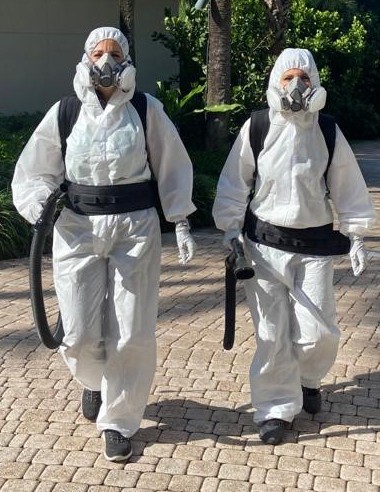
The best to do when trying to clean and protect artwork is to talk to an expert art conservator. These professionals are highly trained and deal with these issues all the time, so they’ll know how to treat your collection without causing further damage.
Stay away from internet advice, especially on public forums.
If you are looking for answers online, view any information you find with caution.
There’s a lot of outdated or false information floating around. Even if something has worked for someone else in the past, their advice may not have long-term impact or suit your particular situation.
For example, one forum advises art collectors to clean their painting with diluted white vinegar. What they neglect to mention is that vinegar is up to 8 percent acidic and can do more harm than good.
If you’re looking for reliable advice and information, here are some trusted resources you should look at:
* MOMA: Dealing with Wet Contemporary Paintings – This is an excellent article that was written for artists after Hurricane Sandy Blew through in 2012, causing severer flooding and storm damage.
* Smithsonian Museum Conservation Institute – A great resource for any questions you have about caring for, protecting, and understanding various types of art. They have especially good advice about professional conservation.
Final Thoughts
If you are ever in doubt about how to prevent mold damage on paintings or you just want to know more about their care, our trained art conservators are your best source of information. Professionals who restore and conserve paintings obtain years of education and experience managing art works that are in various states of disrepair. They will be able to guide you in the preservation and care of your painting to help you keep it in the best condition for the longest possible amount of time.
When you need the services of a professional art conservator, talk to a consultant from Stella Art Conservation about your concerns. We conduct mold remediation on a regular basis and have treated everything from individual pieces to large art collections and masterworks. Time is of the essence, so contact us as soon as possible.

